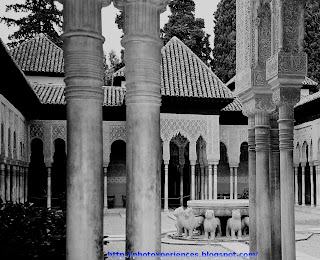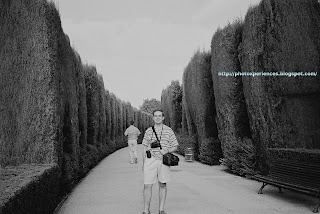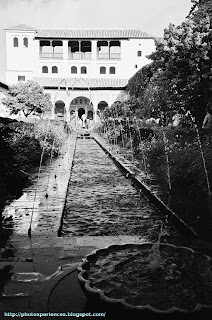La Alhambra. The Alhambra.

El conjunto de la Alhambra es algo más que una fortaleza: dentro de su muralla encontramos palacios reales, jardines, torres, puertas, baños públicos, mezquitas, comercios, etc. Toda una ciudad pensada para cubrir las necesidades de la corte de la dinastía nazarí. Consta de varias zonas diferenciadas, todas ellas extraordinariamente interesantes para visitar: la Alcazaba, los Palacios Nazaríes, el Palacio de Carlos V, el Partal y el Generalife.
The palace complex of the Alhambra is more than a fortress: within the walls we’ll find royal palaces, gardens, towers, mTheosques, shops, gateways, bathhouses, etc. The whole city was designed to meet the needs of the Nasrid dynasty. It consists of several distinct areas, all extremely interesting to visit: the Alcazaba, the Nasrid Palaces, the Palace of Charles V, the Partal and the Generalife.
La Alcazaba. The Alcazaba.

La Alcazaba es el recinto militar fortificado, probablemente construido sobre los restos de una fortificación romana preexistente. Aquí encontramos la Torre redonda del Cubo, las mazmorras, la Plaza de Armas (donde antiguamente se encontraban las casas de los soldados de élite al servicio del Sultán), la Torre de la Pólvora, la Puerta de Armas y la Torre de la Vela, con extraordinarias vistas sobre el Valle del Darro y la ciudad de Granada y sus barrios históricos (el Albaicín y el Sacromonte).
The Alcazaba (citadel) is the fortified military compound, probably built on the remains of a preexisting Roman fortification. Here we can find the round Tower of the Cube, the dungeons, the Parade Ground (where once there were the homes of the elite soldiers in the service of the Sultan), the Powder Tower, the Arms Gate, and the Watchtower of the Candle, with stunning views over the valley of river Darro and the city of Granada and its historic neighborhoods (Albaicin and Sacromonte).
Los Palacios nazaríes. The Nasrid Palaces

Es el conjunto de palacios que constituía la residencia de los reyes de Granada. El palacio real nazarí se concibe como un espacio íntimo, en el que la sobriedad exterior contrasta con la delicadeza del interior, donde los elementos arquitectónicos se tornan puramente ornamentales. Los tres palacios que forman este recinto son: el Mexuar, el Palacio de Comares o de Yusuf I, y el Palacio de los Leones o de Mohammed V.

It’s the set of palaces which were the residence of the kings of Granada. The islamic royal palace is conceived as an intimate space, where the robustness and austerity of the exterior panels harmonizes with the fragility of the interior, where the architectural elements become purely ornamental. Three palaces form this set: the Mexuar, the Palace of Comares or Yusuf I, and the Palace of the Lions or of Mohammed V.

Estos palacios están interconectados por varios patios, que se conforman como jardines interiores, con elementos de inspiración bizantina, persa y musulmana. Los patios son el anticipo del paraíso, un deleite para los sentidos, con el agua como elemento principal, corriendo cristalina entre los mármoles de las fuentes como representación viva de la pureza del alma. Destacamos entre ellos el de Arrayanes, el de Mexuar y el de Lindaraja.
These palaces are interconnected by some courtyards (Patios), which are shaped as constant allusions to gardens, with Byzantine, Persian and Muslim inspired elements. The courtyards are a taste of paradise, an oasis of nomadic sense gratification, with water as main element, running crystalline between the marbles of the fountains as a live symbol of the purity of the soul. Some outstanding examples are the Court of Mexuar, the Court of Myrtles, and the Court of Lindaraja.

El patio que articula toda la zona palatina de la Alhambra es el magnífico Patio de los Arrayanes, uno de los grandes santuarios del arte mundial, puerta de entrada al Palacio de Comares donde se ubicaba el Salón del Trono. Así, todas las embajadas que acudían a Granada quedaban deslumbradas al pasar a través de este estanque de gran luminosidad, en cuyas aguas quietas se reflejan las columnas de la galería norte, la soberbia torre de Comares y el cielo y sus nubes, todo ello adornado con el dulce aroma que emana de los setos de arrayán que flanquean el estanque.
The magnificent Courtyard of the Myrtles is the one that links all the palatine zone of the Alhambra, one of the great shrines of world art. It’s the entrance hall to the Palace of Comares, where the Nasrid court placed the Throne Room. That way, all the embassies feel dazzling when they pass through this pond of still waters in which they can see reflected the columns of the north gallery, the splendid Tower of Comares, and the sky and clouds, all adorned with the sweet aroma emanating from the myrtle hedges flanking the reflecting pool.

El Mexuar era un palacio funcional, de decoración modesta, donde se impartía justicia, y donde se celebran los Consejos de Ministros. Contiguo a él encontramos una pequeña mezquita, y el Cuarto Dorado, de bella techumbre.
The Mexuar was a functional palace, modest in décor, where justice was imparted, and hosted the Councils of Ministers. Next to it we find a little mosque, and the Golden Room, with a gorgeous ceiling.

El Palacio de Comares acogía el Salón del Trono o de los Embajadores, la mayor estancia del recinto, además de 9 pequeñas alcobas. En este salón el Sultán recibía a sus súbditos. Es un resumen de la exquisitez y la delicadeza del arte hispano-musulmán. La cúpula que cubre la sala representa los siete cielos del paraíso islámico, y es un bello corolario para una sala cuyas paredes se tiñen de historia. Fue en este escenario donde Boabdil, el último califa nazarí entregó a los Reyes Católicos Isabel y Fernando las llaves de la ciudad, donde éstos confirmaron a Cristóbal Colón como almirante del Nuevo Mundo, y donde el emperador Carlos V decidió implicarse en varias de sus empresas bélicas.

The Palace of Comares accomodates the Throne Room or Hall of the Ambassadors, the largest room of the palace, along with 9 small alcoves. In this room the Sultan received his subjects. It’s a summary of the refinement and delicacy of the Spanish-Muslim art. The dome covering the room represents the seven heavens of Islamic paradise, and is a beautiful corollary to a room whose walls are pure history. It was in this setting that Boabdil, the last Moorish Caliph, gave the Catholic Monarchs Isabella and Ferdinand the keys to the city, where Christopher Columbus received Isabel and Ferdinand’s support to sail to the New World, and where the Holy Roman Emperor Charles V decided to engage on many of their military companies.

El Palacio de los Leones, a diferencia del anterior, de carácter público y ceremonial, era el refugio privado del Sultán, de su familia y de su harén. En su centro encontraremos el famoso Patio de los Leones. Todo en este patio tiene su simbología: dicen que representa el Paraíso, bañado como éste por cuatro ríos, que fluyen desde los cuatro puntos cardinales hasta la fuente central, donde doce leones de mármol blanco, y de cuyas bocas manan surtidores de agua, representan los doce signos del Zodíaco. El patio está rodeado por un impresionante bosque de 124 columnas de mármol que dan paso a las distintas estancias del Palacio.

The Palace of the Lions, unlike the previous one with a remarkable public and ceremonial character, was the private retreat of the Sultan, his family and his harem. In its center we find the famous Court of the Lions. Everything in this courtyard has its symbolism: it’s said it represents Paradise, bathed like this by four rivers, which flow out from the cardinal point rooms to come together to the central fountain, where twelve lions in white marble produce water from its mouth, representing the twelve signs of the Zodiac. The courtyard is surrounded by an impressive forest of 124 marble columns, which lead to the different rooms of the palace.
En el Palacio de los Leones encontramos la Sala de los Mocárabes, vestíbulo o recepción del palacio; la Sala de los Reyes, la ala de los Abencerrajes, la Sala de las Dos Hermanas, la Sala de los Ajimeces, y el Mirador de Lindaraja. En todas ellas los alarifes agotaron todas las artes decorativas de su tiempo siguiendo el lema del ‘paraíso en la tierra’, no habiendo durante décadas monumento en el mundo que compitiera con su belleza.

In the Palace of the Lions we find the Room of the Muqarnas, or reception hall of the palace, the Hall of Kings, the Hall of Abencerrages, the Hall of the Two Sisters, the Ajimeces Room, and the viewpoint of Lindaraja. In all of them the builders, artisans and craftsmen ran out all the decorative arts of his time following the consistent theme of ‘paradise on earth’, as for decades there was no monument in the world to compete with its beauty.
De todas ellas, destaca la Sala de los Abencerrajes, impresionante por su cúpula de mocárabes en forma de estrella de ocho puntas abriéndose sobre ocho trompas y por su no menos interesante leyenda. El nombre de ‘Abencerrajes’ hace referencia al apellido de una familia de la nobleza de la época, rivales políticos de otra familia, los ‘Zenetes’, los cuales conspiraron contra ellos inventándose una relación amorosa entre la sultana y uno de los Abencerrajes. Así, el sultán, cegado por los celos, celebró una fiesta en esta sala, invitando a toda la familia, y haciendo decapitar sobre su fuente a los 37 caballeros de la misma. De tal forma, se dice que el color rojizo que aun hoy día se puede contemplar en la taza de la fuente, y en el canal que lleva su agua hasta la fuente del Patio de los Leones, se debe a las manchas de la sangre de los caballeros asesinados...
Among them, the Hall of Abencerrages, impressive for its muqarnas (stalactite ceiling decorations) dome with eight-pointed stars, and for its no less interesting legend. The name 'Abencerrages' refers to the surname of a noble family of the time, political rivals of another family, the 'Zenetes', which conspired against them through inventing a relationship between one of the Abencerrages and the Sultan's wife. Then, the Sultan, blinded by jealousy, arranged a banquet in this chamber, invited the whole Abencerrages family, and decapitated the 37 knights of the family. Thus, it’s said that the reddish color that even today can be seen in the basin of the fountain, and in the water channel leading to the source of the Court of the Lions, is due to blood stains of the knights killed ...
El Partal. The Partal.
Saliendo de esta zona palaciega, encontramos los Jardines del Partal, uno de los lugares más hermosos de la Alhambra, que comparte espacio con el terreno antiguamente ocupado por las viviendas de los militares y criados al servicio del palacio, la Torre de las Damas, los restos del Palacio de Yusuf III, las Torres de la Cautiva y de las Infantas (románticos escenarios de algunos de los cuentos de Washington Irving), y el cementerio real o Rauda.

Leaving this palace area, we can find the gardens of Partal, one of the most beautiful places in Alhambra, which shared space with dwellings formerly occupied by the military and the palace servants, the Damas tower, the remains of the palace of Yusuf III, the towers of the Captive and the Princesses (romantic scenaries of some of the stories of Washington IrvinWashington Irvingg), and the royal cemetery or Rauda.
El Palacio de Carlos V. The Palace of Charles V

El Palacio de Carlos V representa el símbolo del triunfo de la Cristiandad sobre el Islam. Fue mandado construir por el emperador CarlosV y la emperatriz Isabel de Portugal con la idea de establecer en él la corte y la capital de su imperio, aunque sus continuas guerras por toda Europa le llevaron finalmente lejos de Granada.

The Palace of Charles V represents the symbol of the triumph of Christianity over Islam. Its construction was ordered by Emperor Charles V and Empress Isabella of Portugal, with the idea of establishing in it the court and the capital of their empire, but their continuous wars throughout Europe finally kept them away from Granada.
El Generalife. The Generalife.
El Generalife se halla a los pies del Cerro del Sol. El nombre parece provenir del árabe Yanat- al- Arif o Jardín del Arquitecto, en una clara alusión simbólica a Dios, Allah, como arquitecto y creador del Universo. En el Generalife, y a los pies de los pabellones blancos encontramos unos amplios jardines donde crecen árboles frutales, olivos, almendros y granados. El Palacio del Generalife constituía la residencia de verano del sultán y su familia, formando parte de un conjunto de almunias y palacios de descanso que la aristocracia nazarí se hizo construir alrededor de la ciudad palaciega de la Alhambra. En uno de sus patios encontraremos el tronco de un ciprés muerto, bajo cuya sombra dicen que se citaba la sultana con con el jefe de la dinastía de los Abencerrajes.

The Generalife is located at the foot of the Cerro del Sol. Its name seems to come from the Arabic al-Arif Yanat or Garden of the Architect, symbolically referring to God, Allah, as the architect and creator of the Universe. There, at the foot of the white pavilions, we find large gardens where they grow fruit trees, olive trees, almond trees and pomegranates. The Palace of Generalife was the summer residence of the Sultan and his family, as part of a set of almunias (villas) and palaces that the Nasrid aristocracy had built around the palace city of Alhambra. In one of their yards we’ll find the dead trunk of a cypress tree, under whose shade it's said that the Sultan's wife was cited with the head of the Abencerrajes dynasty.



Buenas fotos e historia, que más se puede pedir. Saludos.
ResponderEliminarGracias por el comentario. Me alegro que te guste. Saludos.
EliminarWonderful! I visited the Alhambra 20 years ago. Your photo essay brings back great memories. It is an architectural masterpiece that I will never forget! Thanks so much for the beautiful photography and marvelous narative.
ResponderEliminar